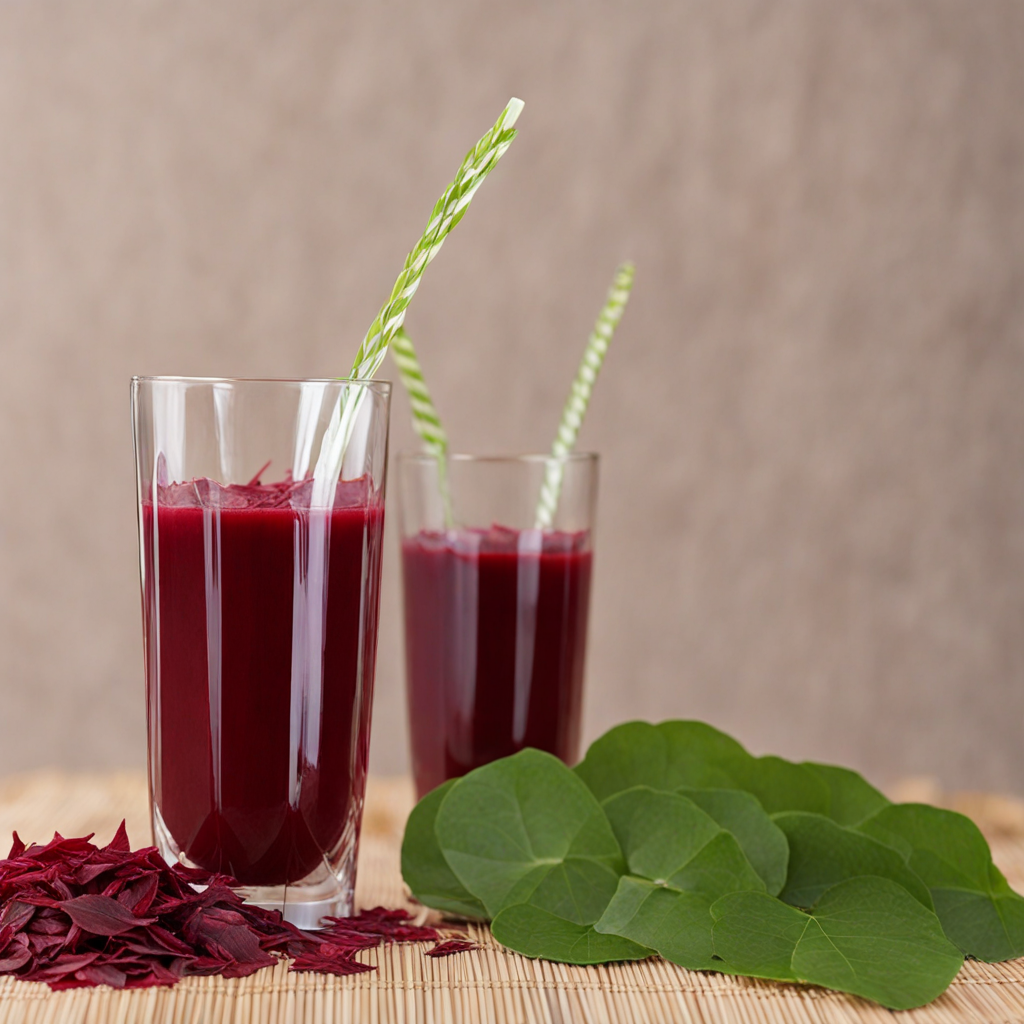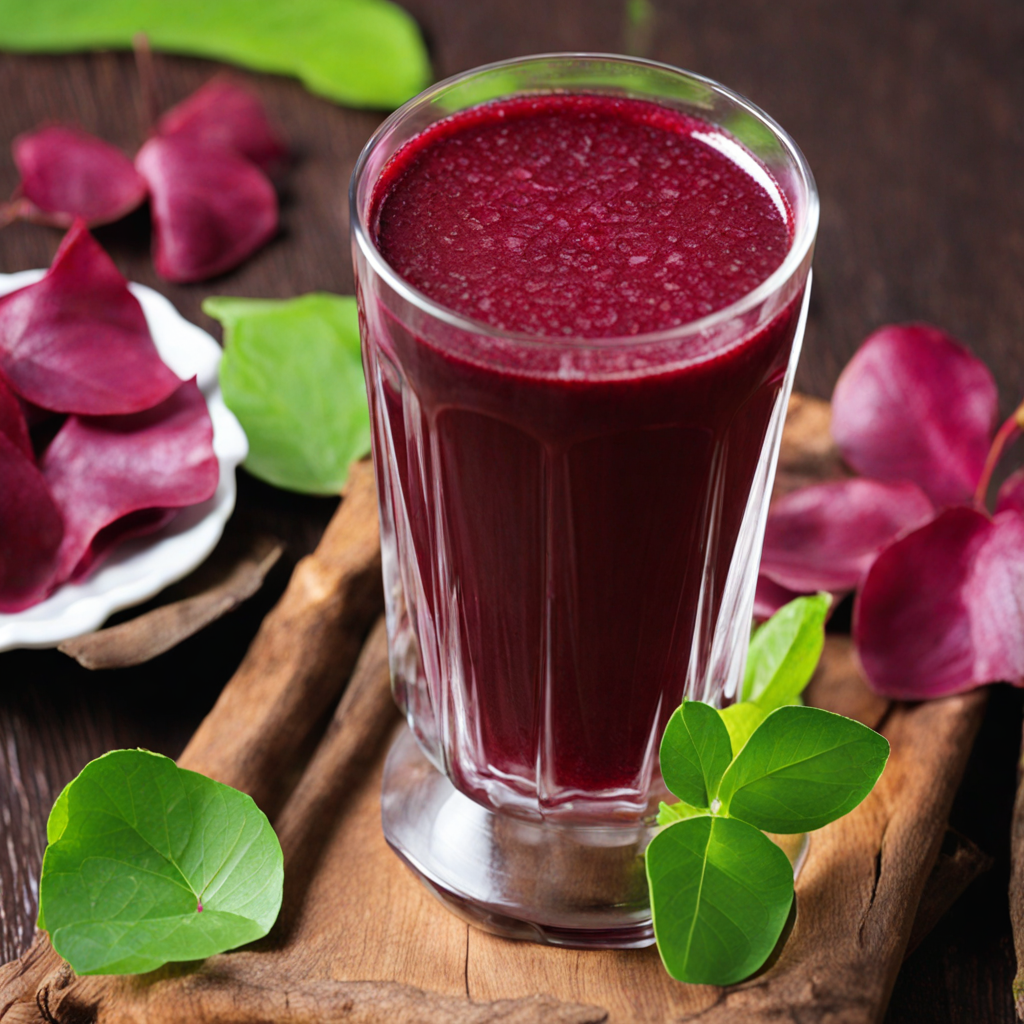Red Sorrel Juice
Red Sorrel Juice, a vibrant and refreshing beverage hailing from Chad, captures the essence of the region’s rich agricultural heritage. Made from the leaves of the red sorrel plant, this juice boasts a striking ruby-red hue that is as enticing as its flavor. The leaves are typically harvested fresh, bringing forth a bright, tangy taste that dances on the palate, reminiscent of a combination between tart cranberries and zesty lemons. This delightful acidity is balanced with a subtle earthiness, making it an invigorating choice for those seeking an adventurous sip. The preparation of Red Sorrel Juice is both simple and communal, often enjoyed during social gatherings or family meals. The leaves are washed, blended with water, and then sweetened with sugar or honey to enhance the natural flavors. Some variations might include added spices like ginger or mint, which elevate the drink's complexity and aromatic profile. Served chilled, this juice is particularly refreshing in the hot Chadian climate, providing a perfect thirst-quencher that revitalizes the body and spirit. Beyond its delicious taste, Red Sorrel Juice is also celebrated for its nutritional benefits. Rich in vitamins and antioxidants, it is believed to aid digestion and boost overall health. The vibrant color and unique flavor profile make it not only a delightful drink to savor but also a beautiful addition to any table setting. For those looking to expand their culinary horizons, Red Sorrel Juice offers a unique taste experience that encapsulates the flavors of Chad, inviting you to explore the depths of this lesser-known beverage.
How It Became This Dish
# The History of 'عصير الحميض الأحمر' (Red Sorrel Juice) in Chad ## Origin and Botanical Background The beverage known as 'عصير الحميض الأحمر' or Red Sorrel Juice is deeply rooted in the culinary heritage of Chad, a country situated in Central Africa that boasts a rich tapestry of cultural influences and agricultural practices. The primary ingredient for this refreshing drink is the hibiscus flower, specifically the species *Hibiscus sabdariffa*, commonly known as roselle. This plant thrives in tropical and subtropical climates and has been cultivated in Africa, Asia, and the Caribbean for centuries. Historically, hibiscus has been used for its culinary, medicinal, and cosmetic properties. The plant's bright red calyces are harvested and dried to create a tart, tangy flavor that forms the base of the juice. In Chad, the use of hibiscus reflects the resourcefulness of local communities who utilize what is naturally available in their environment. ## Cultural Significance In Chad's diverse society, where more than 140 ethnic groups coexist, the preparation and consumption of Red Sorrel Juice hold significant cultural importance. The beverage is not merely a thirst-quencher but also a symbol of hospitality. It is often served during important celebrations, family gatherings, and religious festivities, demonstrating the unity and communal spirit of Chadian people. During Ramadan, for instance, Red Sorrel Juice is commonly served to break fasts due to its refreshing taste and hydrating properties. The drink's vibrant color and tart flavor embody the spirit of renewal and joy that accompanies such celebrations. Additionally, the beverage is appreciated for its health benefits; it is rich in antioxidants, vitamins, and minerals, making it a popular choice for families seeking to maintain good nutrition. ## Development Over Time The history of Red Sorrel Juice in Chad is intertwined with the broader agricultural practices of the region. Traditionally, hibiscus was cultivated through subsistence farming practices, with families planting the crop for both personal consumption and local trade. The harvesting season typically coincides with the end of the rainy season, which ensures a bountiful yield. In the past, the preparation of Red Sorrel Juice was a communal activity. Family members would gather to harvest the hibiscus flowers, dry them in the sun, and then prepare the juice by boiling the dried calyces with water and sweetening it to taste, often with sugar or honey. This process not only reinforced familial bonds but also preserved traditional knowledge and culinary techniques passed down through generations. With the advent of globalization and modern agricultural practices, the production and consumption of Red Sorrel Juice have undergone significant changes. Increased access to markets and the introduction of commercial farming have allowed hibiscus to be grown on a larger scale, making it more widely available. Entrepreneurs have begun to package and sell hibiscus products, including pre-made juice mixes, which have been gaining popularity both locally and internationally. Despite these changes, traditional methods of preparation remain cherished by many families. The art of making Red Sorrel Juice continues to be a cherished skill, often taught to children as a way to preserve their cultural heritage. The drink's connection to local identity is reinforced through its continued presence in communal gatherings, festivals, and everyday life. ## Modern Influence and Global Recognition In recent years, Red Sorrel Juice has garnered attention beyond the borders of Chad. Its unique flavor profile and vibrant color have led to its inclusion in various culinary fusions, and food enthusiasts around the world have begun to appreciate the beverage. It has found a place in cafes and restaurants that highlight African cuisine, and its health benefits have sparked interest among wellness advocates. The global trend toward natural, plant-based beverages has also contributed to the resurgence of interest in Red Sorrel Juice. As consumers gravitate towards less processed options, the drink's natural ingredients and traditional preparation methods resonate with those seeking authenticity in their food choices. Furthermore, the rise of social media has played a role in promoting Red Sorrel Juice. Food bloggers and influencers sharing recipes and experiences with the beverage have helped to raise awareness and appreciation for this traditional Chadian drink. This exposure has not only boosted its popularity but also encouraged a new generation to explore their culinary heritage. ## Conclusion: A Drink of Heritage and Community Today, 'عصير الحميض الأحمر' stands as a testament to Chad's rich cultural heritage, embodying the values of community, tradition, and resourcefulness. While the beverage has evolved over time—from its origins in subsistence farming and communal preparation to its modern-day commercial availability—the heart of Red Sorrel Juice remains unchanged. It is a drink that fosters connections among people, serves as a bridge between generations, and celebrates the natural bounty of the land. As the world becomes more interconnected, the story of Red Sorrel Juice continues to unfold, inviting new audiences to experience its rich flavors and cultural significance. Whether enjoyed at a family gathering in Chad or sipped at a café in a bustling metropolis, the beverage serves as a reminder of the power of food to unite, nourish, and tell the stories of our shared humanity.
You may like
Discover local flavors from Chad







